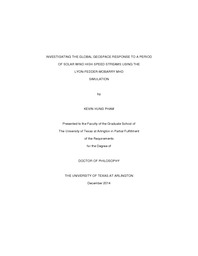
ATTENTION: The works hosted here are being migrated to a new repository that will consolidate resources, improve discoverability, and better show UTA's research impact on the global community. We will update authors as the migration progresses. Please see MavMatrix for more information.
Show simple item record
| dc.contributor.author | Pham, Kevin | en_US |
| dc.date.accessioned | 2015-07-01T17:50:31Z | |
| dc.date.available | 2015-07-01T17:50:31Z | |
| dc.date.issued | 2014-12 | |
| dc.date.submitted | January 2014 | en_US |
| dc.identifier.other | DISS-12939 | en_US |
| dc.identifier.uri | http://hdl.handle.net/10106/24950 | |
| dc.description.abstract | As the solar wind flows past the Earth, it interacts with the Earth's magnetic field and transfers energy and momentum to the geospace environment. During times when the solar cycle is near a minimum, there is a tendency for the Sun to produce high speed streams (HSSs), which are solar wind flows that are faster than the ambient solar wind. The HSSs contain properties that are not typically found in slower ambient solar wind, such as large amplitude Alfvén waves, that affect the transfer of energy and momentum. Large transfers of energy and momentum into the geospace environment that could lead to geomagnetic storms that affect technology that are used every day and possibly damage important global systems such as GPS. We used the Lyon-Fedder-Mobarry (LFM) 3D magnetohydrodynamic (MHD) simulation to study the response of the geospace and ionospheric environment in the presence of HSSs by performing a series of numerical experiments, consisting of simulations of the Whole Heliosphere Interval (WHI), which lasted from March 20 to April 16, 2008. We found that when the amplitude of the solar wind fluctuations were artificially enhanced, that although the total transferred energy increased, the efficiency of the energy transfer was reduced. We show that the reduction in energy transfer efficiency is due to the increased presence of northward magnetic field when the fluctuation amplitudes are large. This conclusion is further supported by the results of a series of numerical idealized experiments that were conducted. The transfer of energy and momentum is regulated by the ionospheric Pedersen conductance. We show results from the LFM simulation that the generally accepted Pedersen conductance values are too low and cause the potentials produced by LFM to be too high. | en_US |
| dc.description.sponsorship | Lopez, Ramon E. | en_US |
| dc.language.iso | en | en_US |
| dc.publisher | Physics | en_US |
| dc.title | Investigating The Global Geospace Response To A Period Of Solar Wind High Speed Streams Using The Lyon-Fedder-Mobarry MHD Simulation | en_US |
| dc.type | Ph.D. | en_US |
| dc.contributor.committeeChair | Lopez, Ramon E. | en_US |
| dc.degree.department | Physics | en_US |
| dc.degree.discipline | Physics | en_US |
| dc.degree.grantor | University of Texas at Arlington | en_US |
| dc.degree.level | doctoral | en_US |
| dc.degree.name | Ph.D. | en_US |
Files in this item
- Name:
- Pham_uta_2502D_12939.pdf
- Size:
- 2.169Mb
- Format:
- PDF
This item appears in the following Collection(s)
Show simple item record


